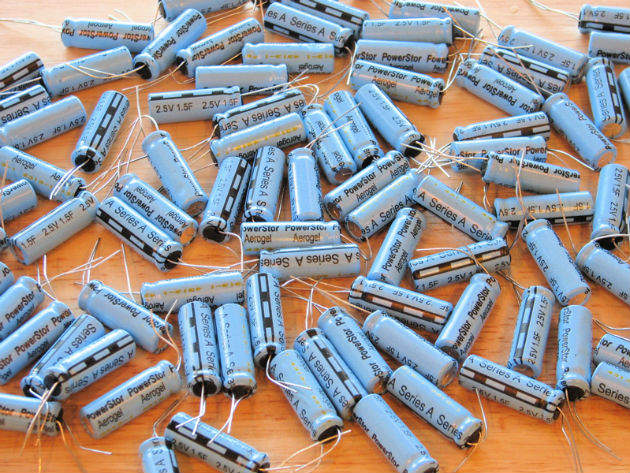
 The University of Surrey and Augmented Optics, in collaboration with the University of Bristol, have created a new polymer they think could be used to create a supercapacitor that is orders of magnitude more effective than current models.
The University of Surrey and Augmented Optics, in collaboration with the University of Bristol, have created a new polymer they think could be used to create a supercapacitor that is orders of magnitude more effective than current models.
Augmented Optics director of research Dr Donald Highgate developed the material for extended wear contact lenses more than 40 years ago. It was adapting this technology that led him to this new breakthrough. Some contact lenses are ionically conductive, and a team began to develop a polymer they thought could potentially be used to connect prosthetics to nerves, allowing a person to control the prosthetic as you would a limb.
From this bionic technology research the electronically conductive polymer was created. Preliminary tests conducted independently at the University of Bristol have proved very promising. Plans are now in place to further develop the material to create a supercapacitor effective and small enough to be used in electric cars.
A supercapacitor breakthrough?
Since supercapacitors were in invented in 1957 by Howard Becker, they have attracted a lot of attention. Supercapacitors store energy by means of static charge; they have very high capacitance and are usually created using two carbon plates. In 2011 Tesla founder Elon Musk said supercapacitors and not batteries would be the true future of electric vehicles.
The new material developed by Augmented Optics and the University of Surrey is a crosslinked hydrophilic electronic polymer that is stable, cheap, and well behaved. Because of its previous use within contact lenses, the material had to be predictable for it to be moulded to exact sizes, so it is very stable. The crosslinked structure of the polymer, meanwhile, ensures it doesn’t melt or warp under heat.
How well do you really know your competitors?
Access the most comprehensive Company Profiles on the market, powered by GlobalData. Save hours of research. Gain competitive edge.

Thank you!
Your download email will arrive shortly
Not ready to buy yet? Download a free sample
We are confident about the unique quality of our Company Profiles. However, we want you to make the most beneficial decision for your business, so we offer a free sample that you can download by submitting the below form
By GlobalDataSee Also:
“The materials appear to have very high capacitance compared to normal supercapacitor electrolytes, and that might indicate that we can make very high energy density supercapacitors,” says Augmented Optics CEO Jim Heathcote. “The report that we have indicates that the capacitances are between three and four orders of magnitude higher than the conventional electrolytes in capacitors with carbon electrodes.”
The polymer is used with PEDOT, which is already commercially available. It is then crosslinked with hydrophilic material, making it electrically conductive. This approach differs from most attempts to advance supercapacitors by replacing the material used as an electrolyte instead of working to increase its surface area.
Supercapacitor problems
Supercapacitors require a very large conductive surface area, which has held back their potential for powering cars due to their size and weight. But advances in nanotechnology are being used to tackle this problem, improving the plate surface area.
“Compared with single-phased material, these hybrid materials with a hierarchical nanostructure can provide shorter ion transport pathways, offer synergetic effects from multiple active components and have easily accessible electroactive sites for the electrolyte ions,” a recent study published in IOP Science explains.
These developments in nanotechnology could be implemented using the new polymer. There is even the suggestion that by using this new material, supercapacitors could be 3D-printed in the future. Should the technology prove successful, a supercapacitor-powered electric car would charge in the same amount of time that it takes to refuel a car with petrol, as opposed to the six to eight hours current electric vehicles take without requiring a larger engine.
Battery technology has long been thought to provide a more environmentally friendly alternative to internal combustion engines and traditional thermal energy plants. But so far there are a multitude of problems, many of which could be solved through the use of supercapacitors – in particular charging time.
Augmented Optics and the University of Surrey’s new material may also be more environmentally friendly than lithium-ion batteries. The makeup of the new polymer does not necessitate the use of rare resources. It uses oil but, as Heathcote points out,“we're talking about relatively small amounts of hydrocarbons to go into these devices. In some of the batteries, they're using quite aggressive chemistry or quite difficult-to-obtain materials; there's a search all around the world for lithium deposits.”
The easily obtainable resources used in the polymer could improve the technology’s ability to become economically competitive.
The energy density wars
At the beginning of the 20th century around half of cars were electric, whilst half had internal combustion engines. Petrol cars proved the favourite and electric cars were abandoned until knowledge of global warming drew researchers and manufacturers back to the concept later in the century. Heathcote believes the key aspect of the combustion engine’s success was its energy density.
“People think that the internal combustion engine defeated the electric motor, but actually it was the energy density of petrol that defeated the energy density of the battery,” he says. “The energy density war has been going for over 100 years.”
Supercapacitors’ energy density has been the main pitfall of the technology thus far. Traditionally they have had just one 20th of the energy density of existing battery technology, necessitating larger supercapacitors that have been unsuitable for use in electric vehicles.
“Supercapacitors at the moment are between three and seven watt hours per kilogram; lithium-ion is around about 100. If [the new polymer] translated into a 100-fold improvement in supercapacitor energy density, that would be three to seven times the energy density of a lithium-ion battery,” Heathcote says. “If that were the case, then you would be able to reduce the weight and the amount of materials going in as the storage system for your car by a very large amount.”
What’s next for the material?
The technology is still in the very early stages, but Augmented Optics has acquired funding allowing it to start building a prototype in the spring of 2017. Following a successful prototype demonstration, Heathcote hopes the supercapacitors could be commercially produced in the UK.“What's likely to happen [initially] is supercapacitors will probably work with batteries of all sorts so that you get a bit of very fast recharging and you also have the higher energy density of batteries with you,” he says.
The true success of supercapacitors will rely on who wins the energy density contest.
“I would imagine there'll be some change depending on whether batteries improve or whether the supercapacitors improve,” says Heathcote. “There's a race to develop a way of storing energy at a high energy density that is economic.”
The material breakthrough could change the vehicle industry by making supercapacitors effective, fast charging and economical. While Heathcote and Highgate are remaining cautious in their optimism, they are aware that should the polymer prove successful, it could change everything.






